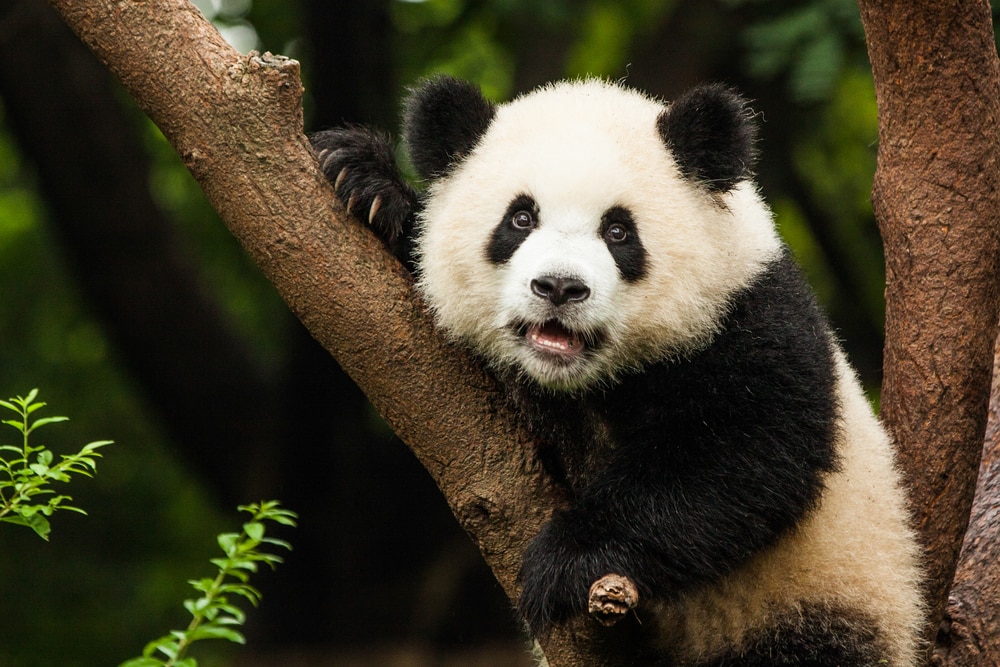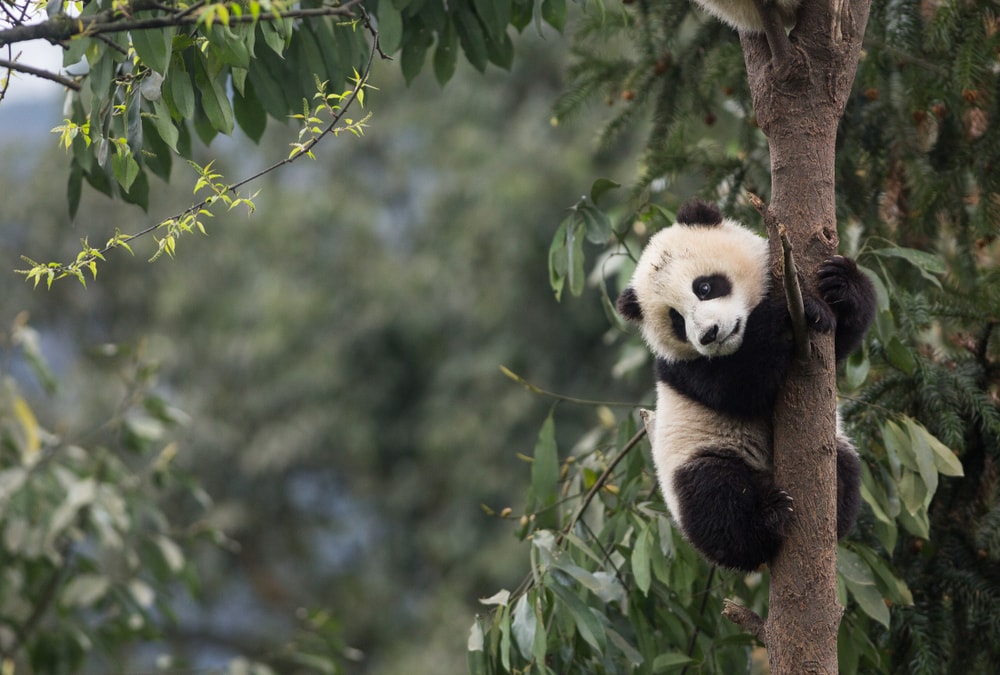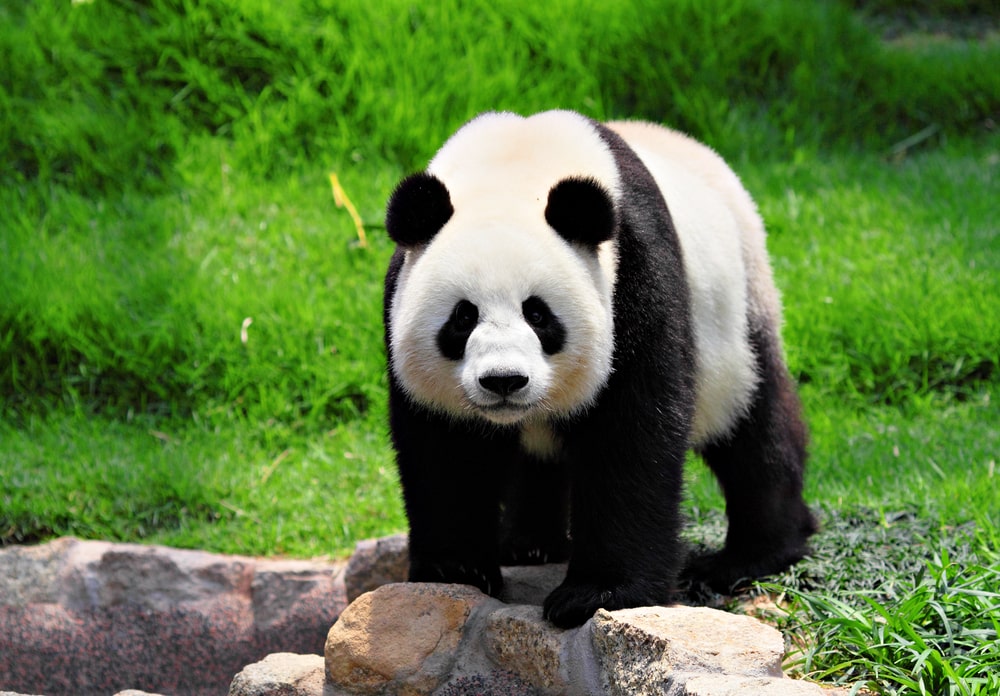Outforia Quicktake: Key Takeaways
- While pandas are generally not aggressive and are one of the least dangerous bears, they can attack and cause harm to humans if provoked or if they feel threatened.
- They are solitary creatures that usually avoid confrontation with humans.
- Pandas primarily eat bamboo and are not likely to see humans as a food source.
- They differ from other bears in their diet, body features, and lack of hibernation.
- Although no longer endangered, pandas still face threats from habitat loss, poaching, and climate change.

Pandas have a reputation for being gentle giants. But have you ever wondered, are pandas dangerous? While they are one of the least dangerous bears, they can still cause harm to humans and other pandas when provoked.
The giant panda is native to Central China. Specifically, they’re found in the Sichuan province and within Shaanxi and Gansu.
They live in the lush bamboo forests peppering the region. There are roughly 1800 pandas living in the wild. There are an additional 600 pandas living in zoos and breeding centers.

Share this image on your site
<a href="https://outforia.com/are-pandas-dangerous/"><img style="width:100%;" src="https://outforia.com/wp-content/uploads/2023/03/are-pandas-dangerous-infographoc-0323-683x1024.jpg"></a><br>are pandas dangerous <a href="https://outforia.com">Outforia</a>Are Pandas Dangerous?

Don’t let the cute videos of these creatures playing in the snow and bumbling around their enclosures fool you.
Giant pandas can be dangerous. They are both similar in size and genetics to other bears. They are most closely related to polar bears. You should always take caution around a creature of that size and strength.
Adults can be anywhere from 2-3 ft (0.6-0.9 m) tall at their shoulders. Males can be up to 280 pounds (127 kg). They have extremely sharp teeth and claws.
With jaws built for grinding up bamboo, their biting pressure adds up to a whopping 292 pounds (132 kg). They could easily bite through a human’s limb if provoked.
For the most part, pandas are solitary creatures. Most of their time is spent relaxing in trees, sleeping, and, of course, eating plenty of bamboo. They avoid confrontation for the most part. If they stumble across a human in the wild, they will likely flee rather than engage.
Issues arise when humans approach them thinking they’re friendly. Whether the human is perceived as a threat or they simply annoy the panda, it could lead to a vicious attack. This is especially true if you encounter a mother with her cubs.
It is quite rare for a wild panda to harm a human but it’s still important to recognize the very real danger they pose. While there are no documented cases of a panda killing a human, there are several reported attacks.

A case study by the International Journal of Clinical and Experimental Medicine examined three attacks that took place at the Beijing Zoo.
In one case, a drunk tourist jumped into the panda enclosure hoping to pet one of the animals. Unfortunately for him, he walked away with a nasty bite to his calf. The incident left him with a skin defect and an open injury.
The last two cases involved tourists accidentally falling into the panda enclosure. The first male tourist that fell in was attacked and ended up with an open composited injury and skin defect to the calf. The next male tourist to fall in was bitten on the foot and right elbow joint.
One of the most severe panda attacks on record happened at the Wolong nature reserve.
In 2016, a Chinese wildlife conservationist, Wei Hua, suffered severe injuries after a female panda he was monitoring attacked. She was with her cub during the incident. He lost seven pints of blood and sustained injuries to much of his body.
How Do Pandas Differ from Other Bears?

While pandas are a part of the bear family, they are quite different from their counterparts. Other bears are generally considered more dangerous.
Furthermore, pandas differ in their diet, body features, and lack of hibernation. Some of these factors are reasons they tend to attack humans less than other bear species.

Diet
Unlike most other bears, the panda primarily eats a vegetarian diet of bamboo shoots and leaves. Other bears will consume just about anything they can get their paws on.
There are roughly 25 species of bamboo in the region wild pandas live in. Some of their favorite varieties include umbrella, arrow, and golden bamboo.
Since pandas are partial to bamboo and other plants, it’s not as likely to hunt other animals. That being said, they also aren’t going to look at humans as a potential food source. That’s one significant factor that reduces wild panda attacks.

Body Features
Pandas have a unique, pad-covered bone in their paws that helps them grip bamboo. While other bears have a similar paw bone, it’s much larger in pandas.
Their eyes are different from other bears too. Most bears have round pupils. Pandas on the other hand have slit-like pupils. Their eyes are much better suited for night vision. This helps pandas sustain their ravenous appetite even after dark.

Hibernation
A majority of bears hibernate. Pandas as well as a couple of other bears such as polar bears, sun bears, and sloth bears don’t need to hibernate. When most bears come out of hibernation, they are constantly looking for a quick bite to eat.
Unlike pandas, other species will go out of their way to seek out areas where people live. If they smell food, they will investigate. This leads to a lot of human-bear interactions.
Pandas are quite content with their year-round diet of bamboo and other plants. And since they don’t hibernate, they don’t have the same motivation to enter human-inhabited areas in search of a post-hibernation snack.
You may also like: The Two Ferocious Bears In Japan: With Pictures And Facts
Are Pandas Peaceful?
Pandas have a reputation for being cute, cuddly, and fairly lazy. They are often dubbed peaceful in disposition. And while they are certainly less vicious than most other bear species, they are not always benevolent and friendly.
People often mistake the slow, steady pace pandas move at as laziness. In reality, since pandas are constantly in search of food, they are actually more active than their hibernating counterparts.
They aren’t necessarily lazy, they just take long slots of time to rest between searching for food.
Although pandas primarily keep to themselves, there are times when they might need to confront another panda. This may happen when males are establishing dominance or competing with females. Pandas may also be aggressive if another panda enters their territory unexpectedly.
How To Stay Safe Around Pandas

It’s not terribly difficult to keep yourself safe from pandas. One general rule of thumb to keep in mind while out in nature is to never approach a wild animal. This is especially true for powerful creatures such as bears. As cute and cuddly as they look, they can cause serious injury.
The odds of encountering a wild panda are quite slim for the average person. You will only run into one if you live in or visit the region of China where they live.
Even if you’re backpacking through the region, it’s unlikely that you’ll run into these rare animals unless you’re in a wildlife reserve.
Remember, if you do happen to encounter a giant panda in the wild, keep your distance. You should be especially alert if you see a mother panda with her cubs. She will fiercely defend her babies if she perceives you as a threat.
Most lucky enough to see a panda will likely visit them in a zoo. As we talked about earlier in this article, there are several incidents involving panda attacks when visitors enter an enclosure.
Never intentionally get into any animal enclosure at the zoo. Also, be sure to keep off of the fences or walls surrounding their habitat. You wouldn’t want to accidentally fall in.
Follow these safety tips if you’re going to be anywhere that you might encounter a bear:

You may also like: 8 Tips For Car Camping In Bear Country
Are Pandas an Endangered Species?

Pandas serve as somewhat of a figurehead for conservation. They were classified as endangered in 1990.
Thankfully, they were moved up to “vulnerable” in 2016 by a report. The National Geographic cites two factors: the decrease in poaching and the huge push for habitat expansion thanks to China’s panda reserves.
Chinese scientists didn’t change the panda’s “endangered” status until 2021. At the time of the announcement, there were roughly 1800 giant pandas living in the wild.
From 2016 to the time of the announcement, China created a Giant Panda National Park to span 70% of pandas’ habitats. At the same time, the captive-breed panda population nearly doubled.
While things are looking up for the panda, they aren’t quite in the clear yet. There are still threats looming for this majestic creature.
Deforestation is still a major issue for pandas and many other species. With less space in the wild, pandas are forced to compete with animals such as the northern Chinese boars for resources which put a strain on both groups. Climate change is also an ever-present threat to pandas and other species.
You may also like: How Far Can A Bear Smell?
Can You Pet a Panda?

If you want to have a chance to safely greet a panda, there are a couple of ways to do so under supervision. Panda fanatics can take a trip to China to volunteer their time to take care of them in zoos and nature reserves.
But be prepared! The job won’t necessarily be glamorous. It will likely involve a lot of manual labor in exchange for getting up close and personal with these creatures.
One program based out of Ya’an City, China lets volunteers spend a week learning about and tending to pandas. The first two days are dedicated to settling in and touring the facility.
Visitors get to spend time at the panda center from day 3 to day 6. All and all, this immersive experience allows volunteers to care for pandas, prepare their food, clean their enclosures, and, of course, pet them.
There are a handful of other programs throughout China that allow visitors to get up close and personal with pandas. Each program will have varying degrees of access to the animals as well as different formats for the experience.
You may also like: Spotting Bears In Arizona: What To Expect
Panda Diplomacy

Panda diplomacy is the act of sending giant pandas from China to other countries as a means of greater diplomacy. They were used as a symbol of peace and friendship.
The program began in 1941. The United States received the first panda. Soong Mei-ling arranged the gift as a “thank you” after the US provided aid to China when they were under siege by Japan. China then gave the US two pandas that were placed in the Bronx Zoo.
This practice of panda diplomacy went on until 1984. The Democratic People’s Republic of Korea, the United Kingdom, and the Soviet Union were some of the countries that were gifted pandas at this time.
Panda diplomacy still exists in some form today but it’s more of a rental program now. After 1984, China started loaning countries pandas for a price of anywhere from $500,000 to $1 million per year. They still retain ownership over the animals.
Panda Fun Facts

Panda FAQs

Now that you know all about how dangerous a panda really is, read on to learn more fun facts about these fascinating creatures.
Are pandas territorial animals?
Pandas tend to keep to themselves in the wild. They mark their territories to keep out unwelcome guests. Each adult will have its own dedicated region to eat and sleep the day away.
When another panda picks up on the scent, it will typically leave the area without a problem. If a panda does encroach on another panda’s territory, this could lead to a fight.
Mating season is the one time pandas tend to socialize with other adults. From around March to May, females use special scent markings to attract prospective suitors.
What are the predators of the panda?
Luckily for the giant panda, there are very few predators that pose a danger to them. Even still, the predators mostly target panda cubs.
Young pandas may be targeted by snow leopards, pumas, or jackals. For the most part, adult pandas are safe from predators due to their large frames, strong bite, and relatively isolated habitat.
What affects a panda’s survival?
Even with few natural predators, pandas still face threats to their survival. Habitat loss and human encroachment are an issue.
Although poaching isn’t nearly as prevalent, pandas are still sometimes hunted for their unique coats. Anyone caught committing this crime can face a minimum 10-year prison sentence.
Global warming is another threat to the panda. As the planet continues to warm, bamboo growth creeps closer and closer to colder climates. Where bamboo goes, pandas will follow.
Can pandas survive in the cold?
Unfortunately, pandas don’t thrive in the cold. As the bamboo forests crawl higher in elevation, pandas will either follow the bamboo to a climate they won’t make it in or stay where it’s warm and be left without their main food source.
What do pandas eat?
Pandas are officially classified as carnivores. This is because they will snack on rodents, birds, or dead animals from time to time.
Despite this fact, they primarily eat bamboo shoots and leaves. They also eat an array of roots and grasses. Captive pandas are fed plenty of bamboo as well as eggs, yams, bananas, and a variety of other foods.
What do pandas do all day?
Eating and sleeping are two of the panda’s favorite activities. They can spend anywhere from 10-16 hours a day feeding. One reason for all this snacking is that bamboo doesn’t hold a lot of caloric or nutritional value.
Pandas need to eat plenty of it to gain the necessary sustenance. Between meals, pandas often nap for about 2-4 hours. Most of the panda’s life is spent eating and sleeping.








